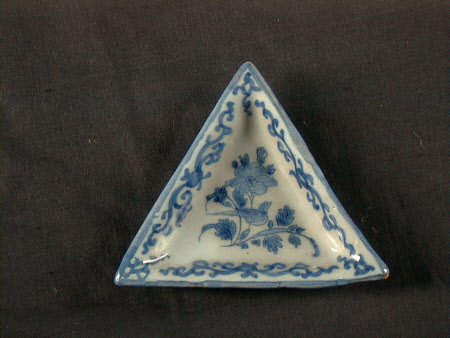Pickle dish
De Witte Ster
Category
Ceramics
Date
1691 - 1705
Materials
tin-glazed earthenware
Measurements
95 mm (Length)
Place of origin
Delft
Order this imageCollection
Dyrham, Gloucestershire
NT 452235
Summary
Pickle or sweetmeat dish, delftware, triangular form with shallow well, De Witte Ster, Delft, Netherlands, ca 1691-1705; hand painted on glaze with cobalt and manganese, with a spray of flowers and foliage at the centre, with a freely painted scrolling border and solid band to the edge of the rim.
Full description
The collection of Dutch delftware at Dyrham is one of the best historical collections of this material in the world, rivalling those at Hampton Court and Chatsworth. Most collections of delftware at this time were assembled by courtiers such as the Duke of Devonshire or the Earl of Portland. William Blathwayt (1649-1717) wasn’t an aristocrat, he was a government administrator – an early civil servant. However, he was a brilliant networker with direct connections to the Palace. He began his career in the Hague as private secretary to the British Ambassador, where he learnt to speak Dutch. Blathwayt served under six monarchs during his long career, including King William III and Queen Mary II, who was herself an avid collector of delftware. Blathwayt’s ceramics reflect his ambition to recreate the fashionable court style of William and Mary in his own home, as well as expressing his loyalty to the crown. The collection of delftware at Dyrham includes rare and unique forms, including some that are likely to have a direct royal connection. Another important aspect is its documentary evidence. Many pieces are listed in inventories of Dyrham made in 1703 and 1710 – around the time the pieces were being acquired by Blathwayt and their early use at Dyrham. About a third of the original collection remains at the property. This useful little dish was originally part of a larger group, described in the 1703 inventory as 13 Triangular Sawcers for Sweetmeats' and in 1710, '12 triangular blew and white Sawcers For Pickles.' 'Sweetmeats' was a term used to describe all sorts of sugared and spiced fruits, biscuits, jellies and other confections that made up the final sweet course of a meal.
Provenance
Indigenous collection purchased by Ministry of Works in 1956 and given to Dyrham Park in 1961.
Marks and inscriptions
Underside of base: [star] 7 (factory mark)
Makers and roles
De Witte Ster , manufacturer
